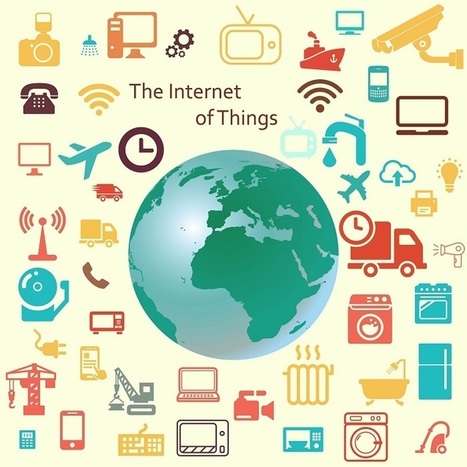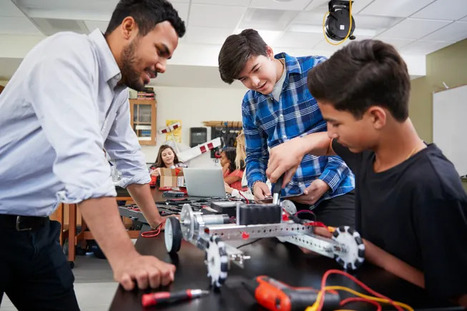 Your new post is loading...
 Your new post is loading...

|
Scooped by
Yashy Tohsaku
Today, 9:42 AM
|
Have you ever wished for a personalized teaching assistant to help with your workload? Transform your teaching with these custom GPTs! Explore this and more at TCEA TechNotes Blog, your go-to source for educational technology and teaching innovation.
This has been designed to be used as a kind of emotional journal, so you can click on the one you are feeling and write a sentence or two about it and why you are feeling that way.
Via Nik Peachey

|
Rescooped by
Yashy Tohsaku
from e-learning-ukr
Today, 7:33 AM
|
This article explores how L&D teams can blend the speed of technology with the soul of human insight to design learning that truly connects.
Via Vladimir Kukharenko

|
Scooped by
Yashy Tohsaku
Today, 7:28 AM
|
A step-by-step guide from the AI & Learning Design Bootcamp to turn any document into a reliable, personalised AI tutor

|
Rescooped by
Yashy Tohsaku
from e-learning-ukr
November 19, 2:01 PM
|
Generative artificial intelligence (AI) can transform higher education by enabling guided engagement at scale, fostering active and dialogic learning,
Via Vladimir Kukharenko

|
Rescooped by
Yashy Tohsaku
from e-learning-ukr
November 19, 2:00 PM
|
The idea of authentic assessments has been around for over 30 years now. In 1990, Grant Wiggins coined the term ‘authentic assessment’ (1) and in recent years this assessment approach has received a considerable boost. The pandemic as well as the rise of AI in education have required educators…
Via Vladimir Kukharenko
Visualize your mind as a living network. Talk with AI and watch your thoughts, beliefs, and emotions unfold before your eyes.
Via Ana Cristina Pratas

|
Rescooped by
Yashy Tohsaku
from Learning & Technology News
November 19, 10:08 AM
|
Regardless of the subject or age group we teach, most of us would like our students to think more critically about what they are learning and how it relates to the world around them.
Via Nik Peachey

|
Scooped by
Yashy Tohsaku
November 19, 10:00 AM
|
Discover six proven strategies to improve student attention, boost participation, and create an engaging, student-centered classroom environment.

|
Scooped by
Yashy Tohsaku
November 19, 9:55 AM
|
This article explores 10 practical, human-centered ways tutors can integrate LLMs into live sessions to enhance learning.

|
Scooped by
Yashy Tohsaku
November 19, 9:52 AM
|
OpenAi GPT 5.1 literally reshaped AI in 2.5 hours damn sam altman.. openai shipped gpt 5.1 and everyone’s calling it a minor incremental bump. they’re completely missing the point. this isn’t …

|
Scooped by
Yashy Tohsaku
November 19, 9:50 AM
|
Take advantage of the "six-seven" chaos and boost engagement with these trendy, themed activities perfect for students in grades three-eight. Explore this and more at TCEA TechNotes Blog, your go-to source for educational technology and teaching innovation.
|
Learning another language could be a total game-changer for your cognitive health.
Via Nik Peachey

|
Rescooped by
Yashy Tohsaku
from e-learning-ukr
Today, 7:34 AM
|
This article explores 10 practical, human-centered ways tutors can integrate LLMs into live sessions to enhance learning.
Via Vladimir Kukharenko

|
Rescooped by
Yashy Tohsaku
from e-learning-ukr
Today, 7:33 AM
|

|
Scooped by
Yashy Tohsaku
November 19, 2:05 PM
|
One expert advises educators to start small with a few community partners when implementing these experiences.

|
Rescooped by
Yashy Tohsaku
from Educational Technology News
November 19, 2:00 PM
|
How will the technology landscape in higher education change in the coming year? We're inviting our readership to weigh in with their predictions, wishes, or worries for 2026.
Via EDTECH@UTRGV

|
Scooped by
Yashy Tohsaku
November 19, 12:35 PM
|
Dear colleague, As I approach the twenty-year mark of my career in education, I’ve probably spent thousands of hours thinking about, experiencing, or leading professional development experien…

|
Rescooped by
Yashy Tohsaku
from TIC & Educación
November 19, 10:09 AM
|
Para utilizar la IA en el aula con criterio, sentido pedagógico y de manera responsable es necesario tener en cuenta algunas recomendaciones.
Via Gumersindo Fernández
ESL English - Adult Literacy - Listening, Reading, Audiobooks, Short Stories, Songs, PET exam
Via Ana Cristina Pratas

|
Scooped by
Yashy Tohsaku
November 19, 9:56 AM
|
Unlock the potential of practical gamification to transform training. Ensure learning translates into effective practice in the workplace.

|
Scooped by
Yashy Tohsaku
November 19, 9:54 AM
|
Leadership can use AI to shape better questions that reveal staff strengths, build trust, and create a school culture connected to its mission and vision.

|
Scooped by
Yashy Tohsaku
November 19, 9:51 AM
|
You’re Using ChatGPT Wrong. Here’s the Prompt Library System That 10x’s Your Productivity. You open ChatGPT. You type a prompt from scratch. You get mediocre results. You refine it. Maybe it …
|






 Your new post is loading...
Your new post is loading...





























IoT means marketing challenges ahead including connectivity of disparate products and data sharing.
IoT means marketing challenges ahead including connectivity of disparate products and data sharing.
IoT means marketing challenges ahead including connectivity of disparate products and data sharing.